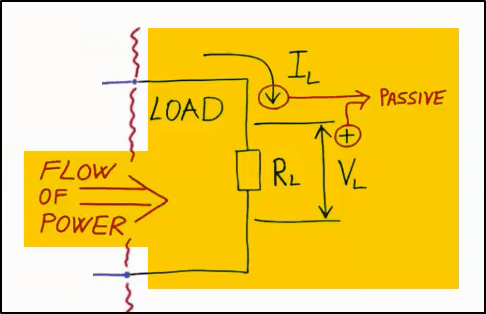The following video contains excerpt from a consultation session I had with one of my students. The audio used in this video clip is an actual session audio. I have only slightly modified the slide to protect the privacy of my student. Feel free to watch the video or scroll below if you prefer reading.
The diagram below can help illustrate the two power sign conventions. We call them active and passive power sign conventions. They apply not only to power engineering systems, but also to all electrical and electronic circuits in general.
Circuits can have many electrical components (or elements). Some of them are sources while others are loads. Most of the times, it is clear whether a component performs a role of a source or a load. However, even when that’s not the case, it is only important to assign one or the other role to each component. Once each component is labeled as a source or a load, we proceed with the use of a corresponding power sign convention and ultimately we obtain positive or negative value for the power flow of a component.

Each side of the power system is normally associated with one of the power flow conventions that determines the sign of a power flow. The source side is considered to be active because power generation happens there. The power flows away from the source. The load side is normally considered to be passive as it normally receives and consumes the power. Thus the power flows towards the load.


We see that the power normally flows from the source and towards the load. When the source generates or delivers power, we consider that power positive. And when the load receives or consumes power, we also consider that power positive.
And then we may wonder: How come the power is positive both for generation and consumption? We may expect that the two powers should have opposite signs because:
- one current (the source current) leaves an element (the source) while
- the other current (the load current) flows into an element (the load)
The explanation is: We apply two different power sign conventions for the two cases. We do that intentionally in order to end up with positive values of power flows in both cases.
We may not always be aware that we use these conventions. In the way we express ourselves and especially when we do power calculations, we apply certain signs and obtain certain values not realizing that we are actually using these conventions.
We can analyze two pairs of statements: one pair is for an inductor and the other pair is for a capacitor. Both inductor and capacitor are generally considered to be loads. All the statements relate these two elements with their reactive power.
For inductors, we say: Inductive load consumes reactive power. Note that we don’t normally say it consumes “positive” reactive power, because when something is positive we simply omit saying the word positive. We just mention the number (the positive value). In our ordinary language, we omit saying that something is positive, but when we encounter negative values, then we do use the word “negative” to emphasize that something is not positive.

The equivalent statement for inductors is: Inductive load delivers negative reactive power. Now, we probably wouldn’t say this for couple of reasons:
- We prefer not using the word “negative” in our statements (if we can avoid it) and also
- When we think of inductors, we think of them as loads and loads consume the power instead of delivering it
However, this second statement is totally correct. We can say something like that if we want to. Inductive load delivers negative reactive power – that’s perfectly fine.
For capacitors, the situation is slightly different – we tend to see both of the statements actually used. Those who prefer positive statements say: Capacitive load delivers reactive power. And, of course, the word “positive” is not necessary to be mentioned. The key word here is “deliver” and power delivery corresponds to active power sign convention.
Thus, by changing the power sign convention from passive to active, we also change how we look at capacitors – namely, we look at them as generators of reactive power instead of loads that consume it. Consequently, the sign of power flow changes from negative to positive and capacitors end up generating (positive) reactive power.

Mathematically, when we work with complex numbers, we find that capacitive load, being a load and thus consuming power, actually consumes negative reactive power. This statement uses the word “negative”, but emphasizes that capacitors are considered loads. This corresponds to using the passive sign convention. It is perfectly fine to say capacitive load consumes negative reactive power.
We can even omit the word “negative” and simply say: Capacitive load consumes reactive power. Such statement is, of course, followed by or accompanied by a value that is negative. Young engineers may be confused with this way of stating as they may assume that the value of consumption is positive. Therefore, it is better to avoid omitting the word negative. Or better yet, simply use the statement that puts in use the active power sign convention.
To summarize, we use active sign convention for sources and passive sign convention for loads. That leads to obtaining either positive or negative values for corresponding power flows. Sometimes, when power flow ends up being negative for an element, we change the power sign convention in order to flip the sign of a power flow. Changing power sign convention boils down to changing the word “deliver” into “consume” and vice versa.


We need to be precise when we express ourselves: Do we talk about consuming, or we talk about delivering? Do we talk about generating, or we talk about absorbing? There are many words and some of them are synonyms. For example:
- On the source side, power is generated or supplied or produced or delivered…
- On the load side, power is consumed, absorbed, used, spent, dissipated etc
The source side terms assume that the power flows away from an element (active power sign convention). The load side terms assume that the power flows towards an element (passive power sign convention). An element can be a generator, resistor, inductor, capacitor, diode, transistor, operational amplifier or any other electrical or electronic component.
This article is Part 1 of the Power Sign Conventions triad of articles. It is recommended that you read all three parts to get a better grasp of how we end up with positive and negative signs of various Electrical Engineering quantities. You can find the next two articles by following the links below:
Alternatively, you can watch the full Power Sign Conventions video that contains all three subtopics in a single video (still not too long – just a little over 9 minutes):
I help my students get clear understanding of various Electrical Engineering concepts. A question of power sign conventions comes up quite often and I know from experience that students get easily confused with varying signs encountered in engineering.
Hopefully, you’ve learned something new today. If you’d like to become my student, you can schedule a consultation session of your own. Just go to eeSasha.com/help and pick the duration and time for your one-on-one consultation session!




